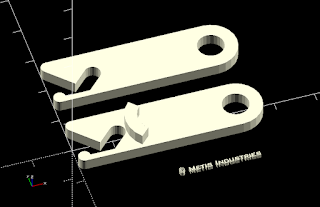Ever seen a Simpleframe manual knitting machine?
 |
| Simpleframe knitting machine |
According to blogger and researcher cleveroldstick, it was invented by Dr. Patrick J. Reilly in 1982 after watching his daughter using a Knitting Nancy--you know, those spool-like holders with 4 nails that you probably used to make cord when you were a kid.
I was doing a lot of weaving and knitting and Kris was somewhat interested. After the Simpleframe was selected as a finalist in the “Prince of Wales Award Scheme for Industrial Innovation and Production" and featured on the BBC television program, Tomorrow's World, I bought one for her.
A query to the Machine Knitting Monthly helpline, notes that when that magazine was launched, it included a Simpleframe supplement with two patterns a month, hints and tips, news and letters.
 |
| CAD drawing of Simpleframe yarn tensioning parts |
I never knit on it and I'm pretty certain that Kris didn't either. The double-bed machine sat in its original bag with the original manual along with a supplement with lots of patterns. I wanted to share it with my knitting machine guild because no one had heard of such a thing. I borrowed it but when I pulled it out, it was missing a couple pieces and one was chewed up. Child, dog, or cat, no one knows.
First order of affairs was replacing the pieces. I found a Simpleframe for sale on eBay, but the bids were too high for couple of pieces. I checked out 3D printers, but don't have a CAD program to draw to spec. Then I went to the Garden State Sheep and Wool Festival and found Metis Industries. The were using a small 3D printer to make drop spindles. (Full story, here.) Ari was confident he could make replacements. He did!
Next: Assembling and knitting on it.






